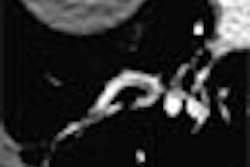The combined use of low-dose spiral CT and FDG-PET scanning may provide reliable detection of early lung cancer, according to Italian researchers from the National Cancer Institute and the European Institute of Oncology in Milan. The preliminary findings from their two-year study are presented in The Lancet.
Investigators performed spiral CT and selective PET scans on over 1,000 heavy smokers. They chose high-risk volunteers (50 years of age or older) who consumed 26 cigarettes a day for 37 years (August 23, 2003, Vol. 362:9384, pp. 593-597).
The protocol followed by Dr. Ugo Pastorino and colleagues consisted of a yearly low-dose spiral CT scan, which was then followed up after a year with a high-resolution CT scan for lesions greater than 5 mm. The FDG-PET scan was then used to further investigate larger non-calcified lesions of larger size (greater than 7 mm) after the high-resolution CT assessment, the authors wrote.
In the following year of assessment (Year 2), they diagnosed 22 cases of lung cancer (11 at baseline, 11 at Year 2). In 298 of the study’s participants (29%), 440 lung lesions were detected, with 95 patients being recalled for high-resolution contrast CT. In 18 out of 20 of the cancer cases, PET scans were positive. Researchers successfully excised malignant tissue in 95% of lung cancers.
"Though we know that randomized trials are appropriate and necessary, we have proven that you can use spiral CT in a much more beneficial, cost-effective way, avoiding extensive examination. In addition, the patient who does not have to undergo such an invasive procedure as needle-tissue biopsy gains considerable benefit," the authors said.
"I am convinced that we can reduce mortality from lung cancer. This is very similar to what happened with breast cancer treatment 20 years ago, when routine mammography was applied," said Pastorino in an interview with AuntMinnie.com.
Pastorino added that "this particular study indicates that CT scan is complimentary and in some cases may replace the need for tissue biopsy. It is not as accurate as biopsy but may be accurate enough in terms of sensitivity to be used as a procedure before a biopsy."
In an accompanying commentary in The Lancet, Dr. Stefan Diederich from the Marien-Hospital, Academic Teaching Hospital in Düsseldorf, Germany, said it remains to be seen whether the protocol designed by Pastorino’s group will actually reduce lung cancer mortality. Early-detection programs may be best suited for those with heavy exposure to carcinogens, he said.
However, Diederich stressed the importance of devising early lung cancer detection programs, given the failure of governments and industry to reduce tobacco consumption.
By Jerry IngramAuntMinnie.com contributing writer
August 22, 2003
Related Reading
Integrated PET-CT better than either alone at staging non-small-cell lung cancer, June 19, 2003
Worrisome radiation dose seen in CT lung screening, follow-up, December 23, 2002
Why CT lung cancer screening will (and won't) work, November 11, 2002
High false-positive rate seen with CT scans for lung, October 22, 2002
Copyright © 2003 AuntMinnie.com




















